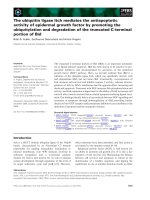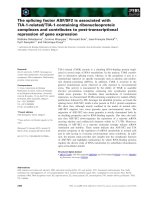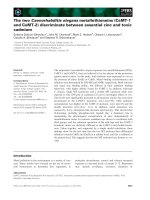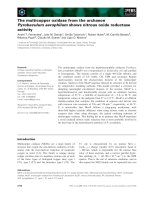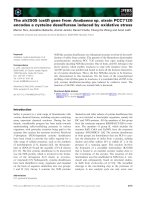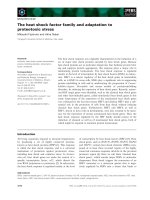Tài liệu Báo cáo khoa học: "The Natural Language Toolkit" docx
Bạn đang xem bản rút gọn của tài liệu. Xem và tải ngay bản đầy đủ của tài liệu tại đây (51.91 KB, 4 trang )
Proceedings of the COLING/ACL 2006 Interactive Presentation Sessions, pages 69–72,
Sydney, July 2006.
c
2006 Association for Computational Linguistics
NLTK: The Natural Language Toolkit
Steven Bird
Department of Computer Science and Software Engineering
University of Melbourne, Victoria 3010, AUSTRALIA
Linguistic Data Consortium, University of Pennsylvania,
Philadelphia PA 19104-2653, USA
Abstract
The Natural Language Toolkit is a suite of
program modules, data sets and tutorials
supporting research and teaching in com-
putational linguistics and natural language
processing. NLTK is written in Python
and distributed under the GPL open source
license. Over the past year the toolkit has
been rewritten, simplifying many linguis-
tic data structures and taking advantage
of recent enhancements in the Python lan-
guage. This paper reports on the simpli-
fied toolkit and explains how it is used in
teaching NLP.
1 Introduction
NLTK, the Natural Language Toolkit, is a suite
of Python modules providing many NLP data
types, processing tasks, corpus samples and
readers, together with animated algorithms,
tutorials, and problem sets (Loper and Bird,
2002). Data types include tokens, tags, chunks,
trees, and feature structures. Interface definitions
and reference implementations are provided for
tokenizers, stemmers, taggers (regexp, ngram,
Brill), chunkers, parsers (recursive-descent,
shift-reduce, chart, probabilistic), clusterers, and
classifiers. Corpus samples and readers include:
Brown Corpus, CoNLL-2000 Chunking Corpus,
CMU Pronunciation Dictionary, NIST IEER
Corpus, PP Attachment Corpus, Penn Treebank,
and the SIL Shoebox corpus format.
NLTK is ideally suited to students who are
learning NLP or conducting research in NLP
or closely related areas. NLTK has been used
successfully as a teaching tool, as an individual
study tool, and as a platform for prototyping and
building research systems (Liddy and McCracken,
2005; Sætre et al., 2005).
We chose Python for its shallow learning curve,
transparent syntax, and good string-handling.
Python permits exploration via its interactive
interpreter. As an object-oriented language,
Python permits data and code to be encapsulated
and re-used easily. Python comes with an
extensive library, including tools for graphical
programming and numerical processing (Beasley,
2006).
Over the past four years the toolkit grew rapidly
and the data structures became significantly more
complex. Each new processing task added new
requirements on input and output representations.
It was not clear how to generalize tasks so they
could be applied independently of each other.
As a simple example, consider the independent
tasks of tagging and stemming, which both oper-
ate on sequences of tokens. If stemming is done
first, we lose information required for tagging. If
tagging is done first, the stemming must be able
to skip over the tags. If both are done indepen-
dently, we need to be able to align the results.
As task combinations multiply, managing the data
becomes extremely difficult.
To address this problem, NLTK 1.4 introduced
a blackboard architecture for tokens, unifying
many data types, and permitting distinct tasks
to be run independently. Unfortunately this
architecture also came with a significant overhead
for programmers, who were often forced to use
“rather awkward code structures” (Hearst, 2005).
It was clear that the re-engineering done in NLTK
1.4 unduly complicated the programmer’s task.
This paper presents a brief overview and tutorial
on a new, simplified toolkit, and describes how it
is used in teaching.
69
2 Simple Processing Tasks
2.1 Tokenization and Stemming
The following three-line program imports the
tokenize package, defines a text string, and
tokenizes the string on whitespace to create a list
of tokens. (NB. ‘>>>’ is Python’s interactive
prompt; ‘ ’ is the continuation prompt.)
>>> text = ’This is a test.’
>>> list(tokenize.whitespace(text))
[’This’, ’is’, ’a’, ’test.’]
Several other tokenizers are provided. We can
stem the output of tokenization using the Porter
Stemmer as follows:
>>> text = ’stemming is exciting’
>>> tokens = tokenize.whitespace(text)
>>> porter = stem.Porter()
>>> for token in tokens:
print porter.stem(token),
stem is excit
The corpora included with NLTK come with
corpus readers that understand the file structure
of the corpus, and load the data into Python data
structures. For example, the following code reads
part a of the Brown Corpus. It prints a list of
tuples, where each tuple consists of a word and
its tag.
>>> for sent in brown.tagged(’a’):
print sent
[(’The’, ’at’), (’Fulton’, ’np-tl’),
(’County’, ’nn-tl’), (’Grand’, ’jj-tl’),
(’Jury’, ’nn-tl’), (’said’, ’vbd’), ]
NLTK provides support for conditional
frequency distributions, making it easy to count
up items of interest in specified contexts. Such
information may be useful for studies in stylistics
or in text categorization.
2.2 Tagging
The simplest possible tagger assigns the same tag
to each token:
>>> my_tagger = tag.Default(’nn’)
>>> list(my_tagger.tag(tokens))
[(’John’, ’nn’), (’saw’, ’nn’),
(’3’, ’nn’), (’polar’, ’nn’),
(’bears’, ’nn’), (’.’, ’nn’)]
On its own, this will tag only 10–20% of the
tokens correctly. However, it is a reasonable tag-
ger to use as a default if a more advanced tagger
fails to determine a token’s tag.
The regular expression tagger assigns a tag to a
token according to a series of string patterns. For
instance, the following tagger assigns cd to cardi-
nal numbers, nns to words ending in the letter s,
and nn to everything else:
>>> patterns = [
(r’\d+(.\d+)?$’, ’cd’),
(r’\.
*
s$’, ’nns’),
(r’.
*
’, ’nn’)]
>>> simple_tagger = tag.Regexp(patterns)
>>> list(simple_tagger.tag(tokens))
[(’John’, ’nn’), (’saw’, ’nn’),
(’3’, ’cd’), (’polar’, ’nn’),
(’bears’, ’nns’), (’.’, ’nn’)]
The tag.Unigram class implements a sim-
ple statistical tagging algorithm: for each token,
it assigns the tag that is most likely for that token.
For example, it will assign the tag jj to any occur-
rence of the word frequent, since frequent is used
as an adjective (e.g. a frequent word) more often
than it is used as a verb (e.g. I frequent this cafe).
Before a unigram tagger can be used, it must be
trained on a corpus, as shown below for the first
section of the Brown Corpus.
>>> unigram_tagger = tag.Unigram()
>>> unigram_tagger.train(brown(’a’))
Once a unigram tagger has been trained, it can
be used to tag new text. Note that it assigns
the default tag None to any token that was not
encountered during training.
>>> text = "John saw the books on the table"
>>> tokens = list(tokenize.whitespace(text))
>>> list(unigram_tagger.tag(tokens))
[(’John’, ’np’), (’saw’, ’vbd’),
(’the’, ’at’), (’books’, None),
(’on’, ’in’), (’the’, ’at’),
(’table’, None)]
We can instruct the unigram tagger to back off
to our default simple_tagger when it cannot
assign a tag itself. Now all the words are guaran-
teed to be tagged:
>>> unigram_tagger =
tag.Unigram(backoff=simple_tagger)
>>> unigram_tagger.train(train_sents)
>>> list(unigram_tagger.tag(tokens))
[(’John’, ’np’), (’saw’, ’vbd’),
(’the’, ’at’), (’books’, ’nns’),
(’on’, ’in’), (’the’, ’at’),
(’table’, ’nn’)]
We can go on to define and train a bigram tagger,
as shown below:
>>> bigram_tagger =\
tag.Bigram(backoff=unigram_tagger)
>>> bigram_tagger.train(brown.tagged(’a’))
We can easily evaluate this tagger against
some gold-standard tagged text, using the
tag.accuracy() function.
NLTK also includes a Brill tagger (contributed
by Christopher Maloof) and an HMM tagger (con-
tributed by Trevor Cohn).
70
3 Chunking and Parsing
Chunking is a technique for shallow syntactic
analysis of (tagged) text. Chunk data can be
loaded from files that use the common bracket or
IOB notations. We can define a regular-expression
based chunk parser for use in chunking tagged
text. NLTK also supports simple cascading of
chunk parsers. Corpus readers for chunked data
in Penn Treebank and CoNLL-2000 are provided,
along with comprehensive support for evaluation
and error analysis.
NLTK provides several parsers for context-free
phrase-structure grammars. Grammars can be
defined using a series of productions as follows:
>>> grammar = cfg.parse_grammar(’’’
S -> NP VP
VP -> V NP | V NP PP
V -> "saw" | "ate"
NP -> "John" | Det N | Det N PP
Det -> "a" | "an" | "the" | "my"
N -> "dog" | "cat" | "ball"
PP -> P NP
P -> "on" | "by" | "with"
’’’)
Now we can tokenize and parse a sentence with
a recursive descent parser. Note that we avoided
left-recursive productions in the above grammar,
so that this parser does not get into an infinite loop.
>>> text = "John saw a cat with my ball"
>>> sent = list(tokenize.whitespace(text))
>>> rd = parse.RecursiveDescent(grammar)
Now we apply it to our sentence, and iterate
over all the parses that it generates. Observe
that two parses are possible, due to prepositional
phrase attachment ambiguity.
>>> for p in rd.get_parse_list(sent):
print p
(S:
(NP: ’John’)
(VP:
(V: ’saw’)
(NP:
(Det: ’a’)
(N: ’cat’)
(PP: (P: ’with’)
(NP: (Det: ’my’) (N: ’ball’))))))
(S:
(NP: ’John’)
(VP:
(V: ’saw’)
(NP: (Det: ’a’) (N: ’cat’))
(PP: (P: ’with’)
(NP: (Det: ’my’) (N: ’ball’)))))
The same sentence can be parsed using a grammar
with left-recursive productions, so long as we
use a chart parser. We can invoke NLTK’s chart
parser with a bottom-up rule-invocation strategy
with chart.ChartParse(grammar,
chart.BU
STRATEGY). Tracing can be turned
on in order to display each step of the process.
NLTK also supports probabilistic context free
grammars, and provides a Viterbi-style PCFG
parser, together with a suite of bottom-up
probabilistic chart parsers.
4 Teaching with NLTK
Natural language processing is often taught within
the confines of a single-semester course, either
at advanced undergraduate level or at postgradu-
ate level. Unfortunately, it turns out to be rather
difficult to cover both the theoretical and practi-
cal sides of the subject in such a short span of
time. Some courses focus on theory to the exclu-
sion of practical exercises, and deprive students of
the challenge and excitement of writing programs
to automatically process natural language. Other
courses are simply designed to teach programming
for linguists, and do not manage to cover any sig-
nificant NLP content. NLTK was developed to
address this problem, making it feasible to cover
a substantial amount of theory and practice within
a single-semester course.
A significant fraction of any NLP course is
made up of fundamental data structures and
algorithms. These are usually taught with the
help of formal notations and complex diagrams.
Large trees and charts are copied onto the board
and edited in tedious slow motion, or laboriously
prepared for presentation slides. A more
effective method is to use live demonstrations
in which those diagrams are generated and
updated automatically. NLTK provides interactive
graphical user interfaces, making it possible
to view program state and to study program
execution step-by-step (e.g. see Figure 1).
Most NLTK components have a demonstration
mode, and will perform an interesting task without
requiring any special input from the user. It is even
possible to make minor modifications to programs
in response to “what if” questions. In this way,
students learn the mechanics of NLP quickly,
gain deeper insights into the data structures and
algorithms, and acquire new problem-solving
skills. Since these demonstrations are distributed
with the toolkit, students can experiment on their
own with the algorithms that they have seen
presented in class.
71
Figure 1: Two Parser Demonstrations: Shift-Reduce and Recursive Descent Parsers
NLTK can be used to create student assign-
ments of varying difficulty and scope. In the sim-
plest assignments, students experiment with one of
the existing modules. Once students become more
familiar with the toolkit, they can be asked to make
minor changes or extensions to an existing module
(e.g. build a left-corner parser by modifying the
recursive descent parser). A bigger challenge is to
develop one or more new modules and integrate
them with existing modules to perform a sophis-
ticated NLP task. Here, NLTK provides a useful
starting point with its existing components and its
extensive tutorials and API documentation.
NLTK is a unique framework for teaching nat-
ural language processing. NLTK provides com-
prehensive support for a first course in NLP which
tightly couples theory and practice. Its extensive
documentation maximizes the potential for inde-
pendent learning. For more information, including
documentation, download pointers, and links to
dozens of courses that have adopted NLTK, please
see: .
Acknowledgements
I am grateful to Edward Loper, co-developer of
NLTK, and to dozens of people who have con-
tributed code and provided helpful feedback.
References
Marti Hearst. 2005. Teaching applied natural language
processing: Triumphs and tribulations. In Proc 2nd
ACL Workshop on Effective Tools and Methodolo-
gies for Teaching NLP and CL, pages 1–8, ACL
Elizabeth Liddy and Nancy McCracken. 2005. Hands-
on NLP for an interdisciplinary audience. In Proc
2nd ACL Workshop on Effective Tools and Method-
ologies for Teaching NLP and CL, pages 62–68,
ACL
Edward Loper and Steven Bird. 2002. NLTK: The
Natural Language Toolkit. In Proc ACL Workshop
on Effective Tools and Methodologies for Teaching
Natural Language Processing and Computational
Linguistics, pages 62–69. ACL.
David Beasley. 2006. Python Essential Reference, 3rd
Edition. Sams.
Rune Sætre, Amund Tveit, Tonje S. Steigedal, and
Astrid Lægreid. 2005. Semantic annotation of
biomedical literature using Google. In Data Min-
ing and Bioinformatics Workshop, volume 3482 of
Lecture Notes in Computer Science. Springer.
72



